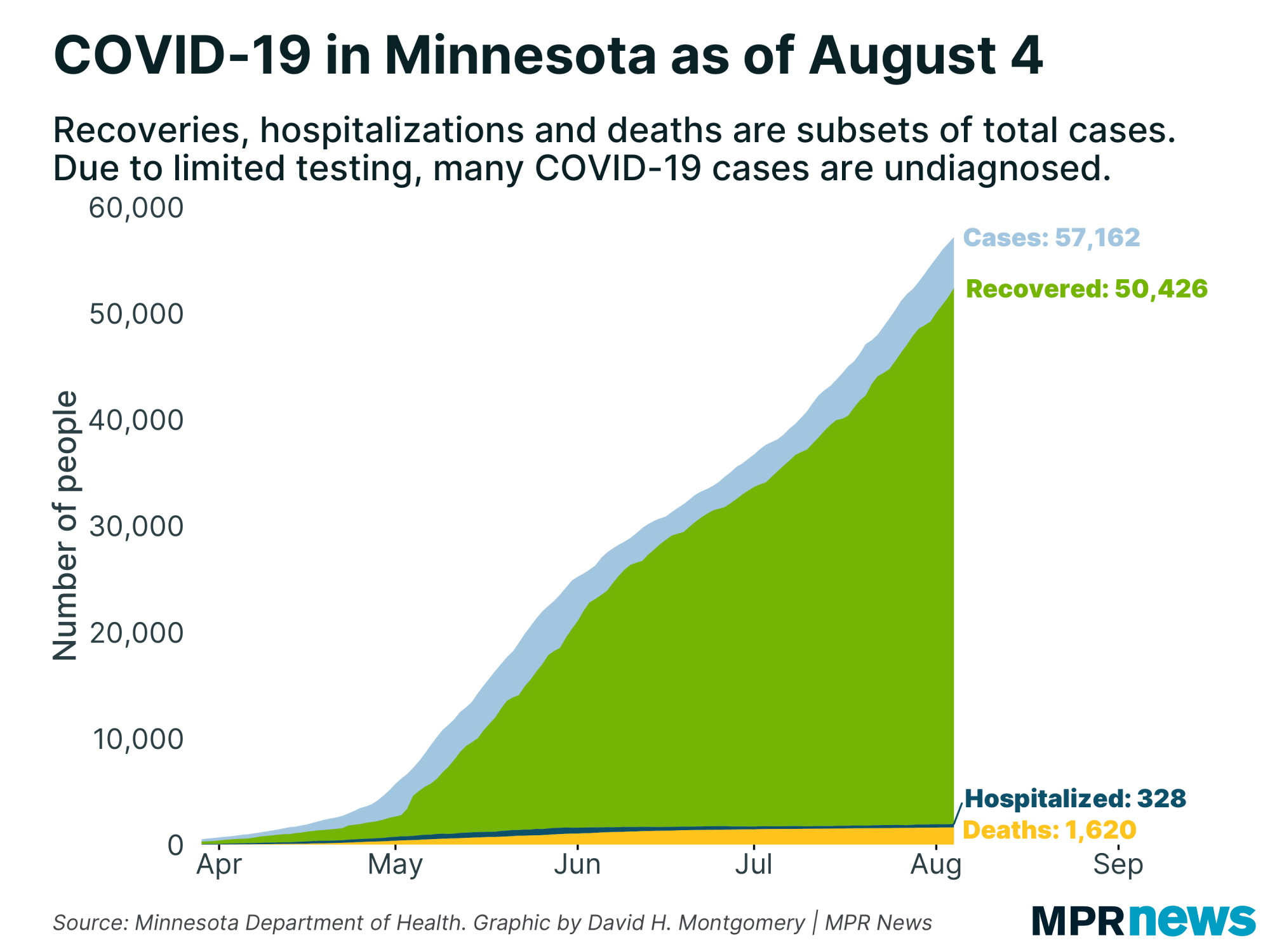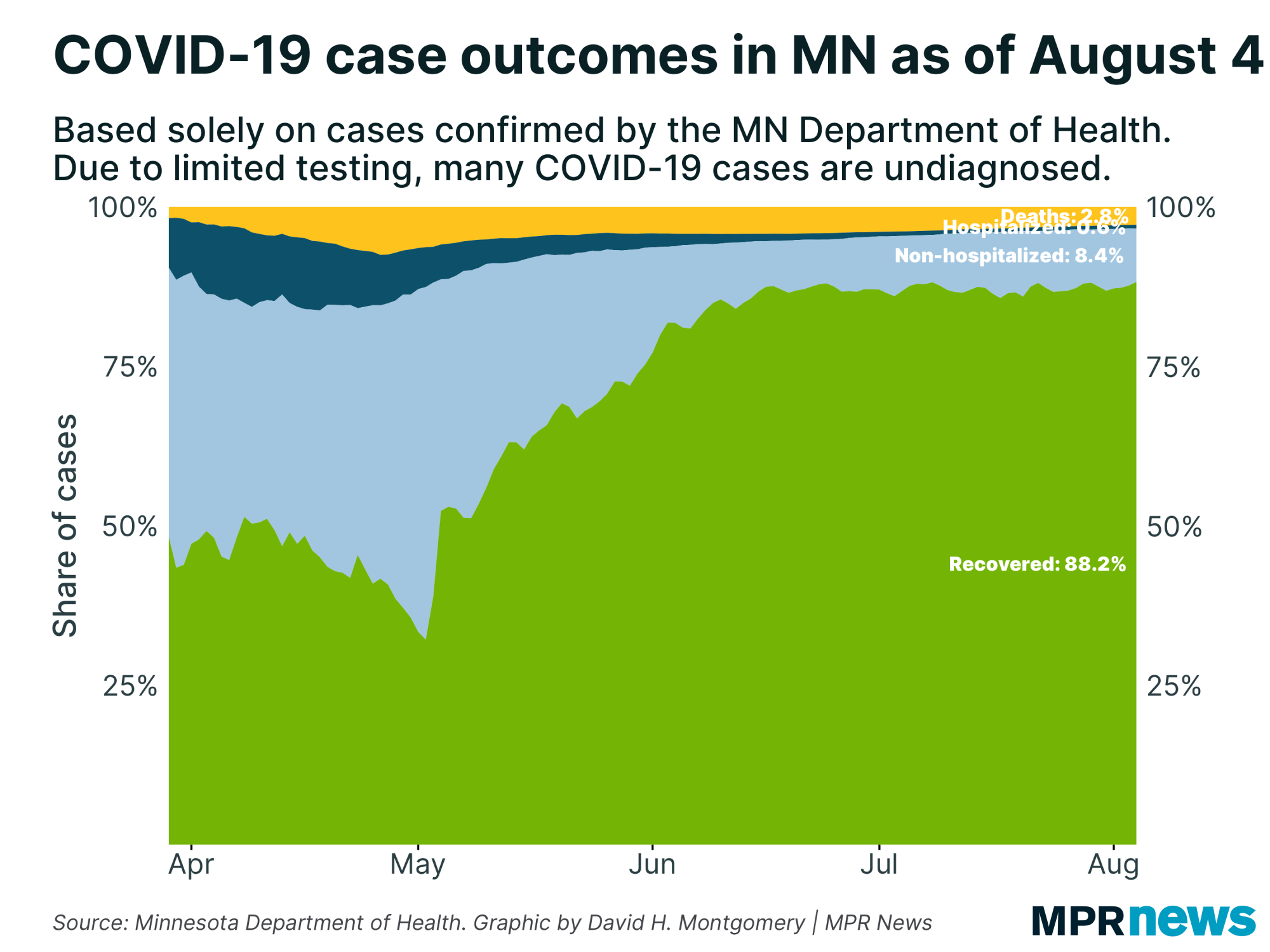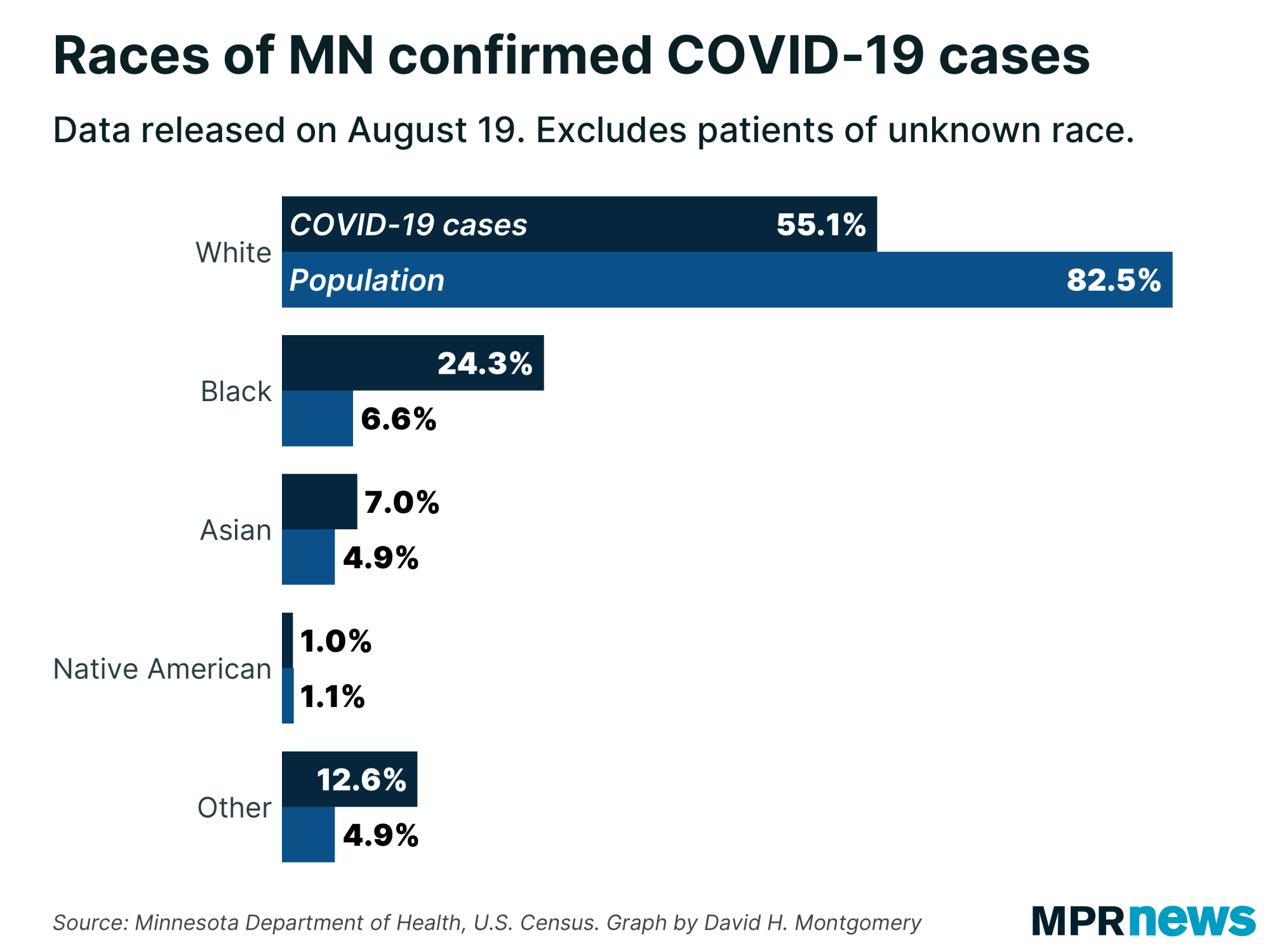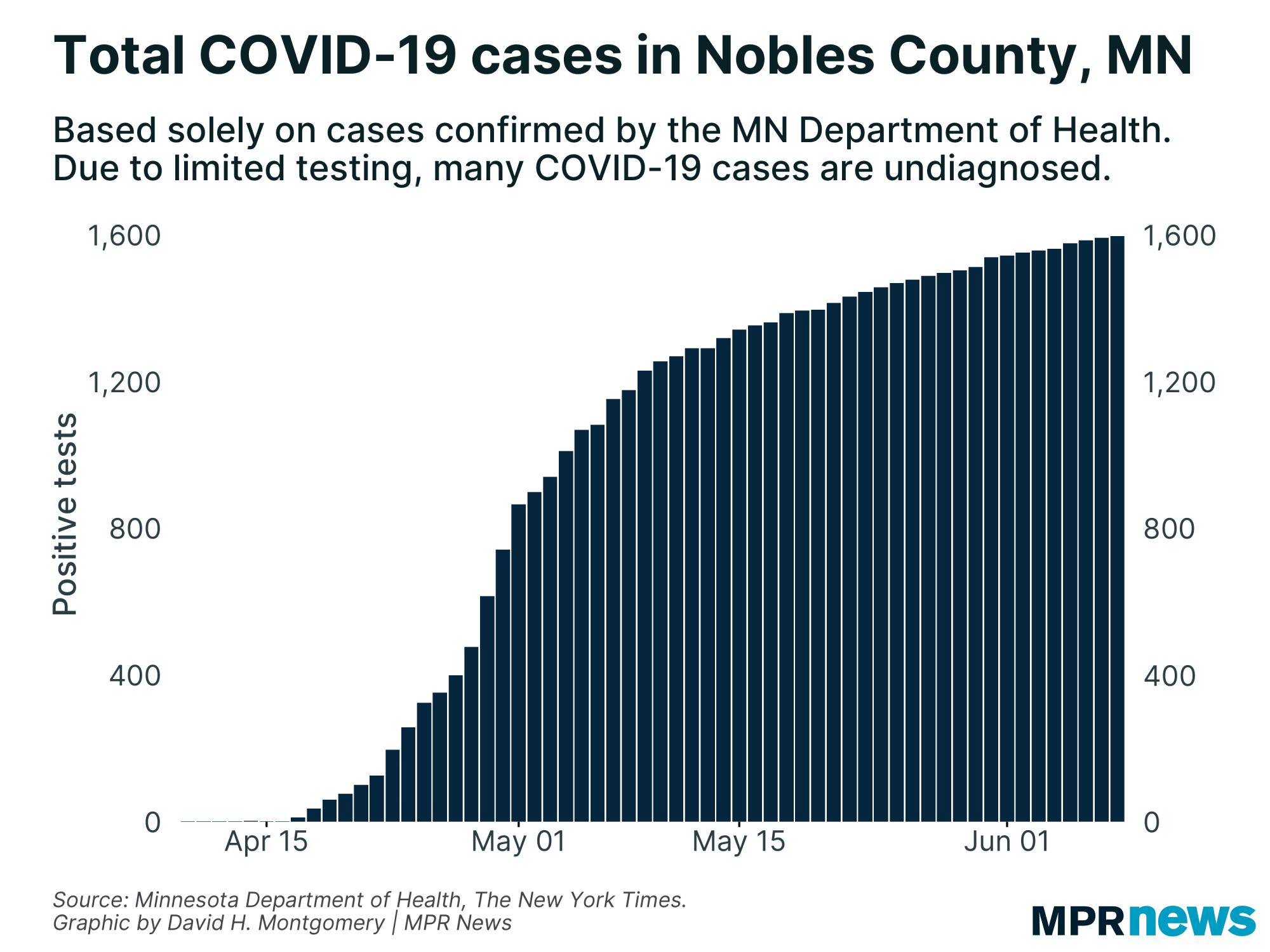May 2 update on COVID-19 in MN: 24 more deaths, nearly 500 more confirmed cases

Go Deeper.
Create an account or log in to save stories.
Like this?
Thanks for liking this story! We have added it to a list of your favorite stories.
Updated: 4:30 p.m.
Minnesota on Saturday reported 24 more COVID-19 deaths and 498 more confirmed COVID-19 cases.
The confirmed death toll in the state since the start of the pandemic is now 395, with 6,228 confirmed cases as the state has ramped up testing.
The big jump in cases confirmed in the past few days, driven by the testing increase, pushed down the percentage of people who’ve recovered from the disease, to around 40 percent. Prior to this week, recoveries had been running about half of total cases.

As restrictions relax and testing ramps up, health leaders said Minnesotans should expect to see the COVID-19 outbreak widen, but they expressed confidence that Minnesota’s health care system was prepared to deal with an expected surge of cases and hospitalizations.
Turn Up Your Support
MPR News helps you turn down the noise and build shared understanding. Turn up your support for this public resource and keep trusted journalism accessible to all.
The state on Thursday reported 3,532 completed tests from the prior day — the first time daily testing topped 3,000. On Friday, the state topped 4,000 tests for the first time, reporting 4,553 completed. On Saturday, the total new tests fell slightly but remained above 4,000, with a total of 4,178.
Gov. Tim Walz said the state should be testing 5,000 people daily as part of the plan to reopen the economy.

Health Commissioner Jan Malcolm on Friday offered some good news on that front. She said federal officials have come through with supplies of nasal swabs crucial to the state’s testing ramp-up, which will help give Minnesota access to a total of 190,000 swabs during May.
Noting that federal guidelines recommend states don’t start to reopen their economies before seeing a two-week downward trend in COVID-19 cases, Malcolm said: “We’re a long way from that.”
Here are the latest coronavirus statistics:
6,228 cases confirmed via 79,007 tests
395 deaths
1,159 cases requiring hospitalization
389 people remain in the hospital; 135 in intensive care
2,397 patients recovered

The deaths reported Saturday included 17 residents of Hennepin County, three residents of Anoka County, and two each from Clay and Ramsey counties.
Most of the deaths reported Saturday were people in their 70s or older — though state health officials noted that one person who died in Hennepin County was in their 40s and "had no underlying conditions and was not in long-term care." State officials said they're not releasing any further information about that case.
Twenty-one of the 24 deaths reported Saturday were residents of long-term care facilities, which to date have seen the majority of COVID-19 deaths in Minnesota.
On a media call Friday, state officials cautioned families against removing loved ones from group-care facilities.
The Minnesota Department of Health's Kris Ehresmann said families need to consider whether they can provide the specialized care those facilities offer, as well as the duration of the pandemic.
"It's not a short-term situation. It's not, 'Well, if we could just take Mom or Dad home for the weekend, that would make a big difference.' This is months and months," she said.
Officials also said moving someone from a long-term care facility can be dangerous and disruptive to their health.
There are more than 100 facilities in the state with at least one COVID-19 case, although many have only one or two cases. Twenty-one facilities have 20 or more cases, Ehresmann said.

Stay-home order extended for two more weeks
The latest numbers come two days after Gov. Tim Walz extended his stay-at-home order but allowed some additional retail store operations. Bars and restaurants, however, remain takeout-only until May 18.
Retailers and other businesses will be able to offer curbside pickup of purchases starting Monday, putting up to 30,000 Minnesotans back on the job, the governor’s office said. Dog groomers can work, too, if pets are picked up and dropped off curbside.
Other customer-focused businesses, however, will likely remain disappointed. For example, salons and barbershops can sell products for curbside pickup but still can’t provide haircuts or other in-shop services.
Earlier this week, Walz allowed some factory and office workers who don’t have customer-facing jobs back into their work spaces, with safeguards. On Wednesday, he expressed hope that smaller businesses could soon reopen with social distancing and other hygiene measures in place.
The governor, though, has made clear that places that depend on public crowds, including bars, eateries and big sporting events, would be among the last to return to normal business operations.
While state leaders recognize the disruptions to daily life, “we do have sort of an index of caution around the fact that we’re seeing the case numbers increase rapidly” as testing ramps up, Malcolm said.
Health authorities, she added, have been “very sobered” by outbreaks in southwestern Minnesota and other hot spots, and “at a time when we feel like we’re just getting our arms around the true spread of the disease, there’s some reluctance to open more broadly.”

Protesters gathered at the Minnesota Capitol on Saturday to voice their opposition to Walz’s orders. They say the stay-at-home measures are causing too much damage to the economy and are infringing on their personal freedoms.
They circled the Capitol in dozens of vehicles, honking their horns, while dozens more protesters gathered on foot.
Pandemic could last two years, U scientists say
The COVID-19 outbreak will likely last 18 to 24 months, according to new report by University of Minnesota researchers.
COVID-19 appears to spread more easily than flu because of a longer incubation period and more spread among people who have no symptoms, the U’s Center for Infectious Disease Research and Policy writes.
With only an estimated 5 to 15 percent of the U.S. population infected at this point, the country should expect more waves of illness, and it likely won’t end until 60 to 70 percent of the population is immune, the scientists said.
Deal near on elective surgeries, dental visits
Walz said Thursday that talks are underway with medical professionals about restarting elective surgeries and dental care visits.
The governor had put a hold on those procedures to preserve crucial protective gear and equipment needed to respond to a surge in COVID-19 cases. On Thursday, he said that hospitals, so far, have enough gear to handle the cases.
On Friday morning, Walz told WCCO radio that an announcement on elective medical procedures would probably come on Monday.
State officials also said it's possible that restarting routine dental visits could also be on the same timeline as elective surgeries.
Developments from around the state
Central, SW Minnesota outbreaks; meat supply concerns widen
As testing accelerates, more cases are discovered. That’s especially true in southwestern Minnesota, where an outbreak centered in Nobles County around the massive JBS pork plant in Worthington continues to mushroom.
Confirmed cases in the county jumped from one on April 13 to 899 on Saturday. It’s the largest outbreak in Minnesota outside the Twin Cities and the largest by far relative to the county’s population.
Beyond the ill and unemployed workers, the cascading effects of the shutdown of JBS and of the massive Smithfield Foods pork processing plant in Sioux Falls, S.D., are also hitting pork producers hard. With those plants down, farmers have few places to sell the animals and so are being forced to destroy them.
At a Wednesday press conference, Minnesota DFL U.S. Rep. Collin Peterson said state officials together with JBS executives and union leaders would be working on a plan that would allow the plant to reopen while keeping workers safe and tested as they enter.

Meanwhile, Stearns County in central Minnesota is also reporting a big jump in coronavirus cases tied to two meatpacking plants.
The county started the week with 55 positive cases of COVID-19. By Saturday, the number had mushroomed to 531, with 96 more confirmed cases reported in the previous day as testing intensified.
That increased testing included people tied to two poultry plants, Pilgrim's Pride in Cold Spring and Jennie-O Turkey in Melrose, where an undisclosed number of workers have tested positive for the virus.
And Kandiyohi County in west-central Minnesota is also seeing cases jump a week after officials with the Jennie-O turkey processing plant said some employees had tested positive for the coronavirus.
A week ago, the county where the Willmar plant is located had confirmed three COVID-19 cases. On Saturday, the state Health Department reported 145 people in Kandiyohi County have now tested positive.
— MPR News staff
Mpls. City Council approves budget cuts to help fund PPEs
Minneapolis City Council members on Friday voted to cut their office budgets in order to free up more than $60,000 for protective equipment.
The city will use the money to buy masks, hand sanitizer, thermometers and other items that can help fight the spread of COVID-19. Council members say low-income residents will be first in line to get the goods. The pool of money also includes $10,000 from Mayor Jacob Frey's office budget.
According to the most recent data, 487 Minneapolis residents are infected with the virus and 61 have died from it.
Frey has acknowledged the virus is hurting the city's most vulnerable populations. He says more than 80 percent of confirmed fatalities in Minneapolis have occurred in senior care centers and other congregate housing facilities.
— Brandt Williams | MPR News
St. Cloud State has first confirmed COVID-19
St. Cloud State University is reporting its first positive case of the coronavirus.
In an email to faculty and students, St. Cloud State President Robbyn Wacker said only that a member of the university community has reported being diagnosed with lab-confirmed COVID-19.
University officials wouldn't provide any details about the person's condition or when they were last on campus.
But Wacker's email says the Minnesota Department of Health has determined that the risk of exposure at the university is low.
A St. Cloud State spokesperson says the university continues to clean and sterilize the facilities that are open. He said they're working with the Health Department to identify any close contacts of the person who tested positive.
— Kirsti Marohn | MPR News
Minneapolis Public Schools to have virtual graduation ceremonies
Seniors graduating from Minneapolis Public Schools won't be walking across a stage to get their diplomas this spring, but they'll still get their rite of passage. The district announced Friday that graduation ceremonies will be going virtual for the first time.
Officials say they plan to air the ceremonies for each high school on Facebook Live and on a Minneapolis cable-access channel.
Other schools are also hosting virtual ceremonies during the COVID-19 pandemic. Winona State University announced it will honor its 1,400 graduates in a virtual celebration May 8.
— Brandt Williams | MPR News
Walz OKs food trucks at highway rest stops
The governor on Friday signed an order permitting food trucks to operate at up to six highway rest stops in Minnesota.
With restaurants shut across the country, making food trucks available at rest stops will aid long-haul truckers “who play a critical role in supporting the supply chain and depend on eating their meals on the road,” the governor’s office said.
— MPR News Staff
State’s jobless aid fund feels the pressure
Minnesota’s unemployment insurance trust fund is already down one-third from the balance it was at when a wave of layoffs began in response to coronavirus measures.
In mid-March, the head of the Department of Employment and Economic Development said the account used to pay state jobless benefits had $1.5 billion in it. As of this week, agency spokesperson Jacob Loesch said that balance has shrunk to about $1 billion.
It’s just one measure of the economic toll stemming from COVID-19 related business restrictions or closures. The state is nearing 600,000 applications for unemployment assistance since mid-March.
The strain on the account could ease a bit as more businesses come back on line. And Commissioner Steve Grove has said Minnesota probably wouldn’t exhaust its account for several months.
If Minnesota’s fund were to be depleted due to high payouts, the state would borrow from a federal unemployment trust fund with some interest.In Minnesota, the maximum weekly benefit is $742. But the federal government has tacked on $600 more per week and is footing those costs.
— Brian Bakst | MPR News
Top headlines
Family's illnesses suggest coronavirus may have been in Minnesota longer than thought: Kate Austin came home from Japan in late January with a strange illness she couldn’t seem to beat. Her arrival caused a chain reaction of sickness among friends and family that ultimately ended in a coronavirus diagnosis.
Businesses scramble to lay plans for partial reopening: More than a month after Gov. Tim Walz issued a stay-at-home order, some nonessential retail businesses will be allowed to partially reopen on Monday, offering curbside pickup or delivery. Those services, however, are easier for some businesses than others.
Pandemic aggravates Minnesota care center staffing shortages: Staffing has become such a challenge at some Minnesota care facilities due to the coronavirus outbreak that a few aren't sure how they're going to get through the weekend, the head of an industry group said Friday.
St. Paul advocates move online to help domestic abuse survivors: On a normal day, the staff at Women’s Advocates of St. Paul have a tough job. But with in-person contact limited, they’ve had to change the way they help domestic abuse survivors.
Bachelor Farmer closure shakes pandemic-weary restaurant industry: Fine dining restaurants and those with multiple locations seem to be taking the biggest hit, as Minnesota’s stay-at-home order heads into a seventh week.
Healthy pigs being killed as meatpacking backlog hits farms: Officials estimate that about 700,000 pigs across the nation can't be processed each week and must euthanized. Most of the hogs are being killed at farms, but up to 13,000 a day also may be euthanized at the JBS pork plant in Worthington, Minn.
Dispute over taxes complicates state COVID-19 response: The DFL House and Republican Senate are taking distinctly different approaches to the COVID-19 crisis in the final two weeks of the legislative session.
This year, farmers markets aim to offer comforting tradition. Plus produce: With their outdoor space and flexible layouts, farmers markets may be able to adapt more easily to the needs of shoppers during a pandemic.
COVID-19 in Minnesota
Health officials for weeks have been increasingly raising the alarm over the spread of the novel coronavirus in the United States. The disease is transmitted through respiratory droplets, coughs and sneezes, similar to the way the flu can spread.
Government and medical leaders are urging people to wash their hands frequently and well, refrain from touching their faces, cover their coughs, disinfect surfaces and avoid large crowds, all in an effort to curb the virus’ rapid spread.
The state of Minnesota has temporarily closed schools, while administrators work to determine next steps, and is requiring a temporary closure of all in-person dining at restaurants, bars and coffee shops, as well as theaters, gyms, yoga studios and other spaces in which people congregate in close proximity.



